In the Western Asian country of Iran, dog ownership has long been a contentious issue.
And as of recently, freedoms that people like you and me take for granted daily are being removed from Iran.
What freedoms am I talking about? Dog walking.
Recently, Iran’s Capitol city has banned citizens from walking their dogs in public spaces.
Those who ignore the ban can be hit with hefty fines and even confiscation.
According to a police chief there, the ban resulted from the “fear and anxiety” that dogs create among members of the public.
And while these bans are being created, it doesn’t seem everyone in Iran is taking to them well.
Many dog owners in the country still welcome dogs as part of their family and love them as one of their own.
So in an attempt to fight back against laws like such, I want to shed some light on some of the amazing dogs from Iran.
Today we’ll talk about the seven Iranian dog breeds.
So without further ado, let’s introduce you to some of these amazing breeds.
1) Saluki (Persian Greyhound)

Description:
The Saluki, also referred to as the Persian Greyhound, Arabic Hound (sometimes Arabian Dog), and gazelle hound, is, like other greyhounds, very tall, with long, and slender legs, with a narrow body, slim waist, and a deep chest.
They range from 23 to 28 inches tall and weigh anywhere between 35 to 65 pounds, with females on the lesser end.
The breed has long, floppy ears covered with long, silky hair and a long tail covered with fur.
With exception to the ears, the tail, and a few other places on the body, Saluki is covered with a soft, short coat of fur.
In some cases, smooth varieties of the breed are available, in which all hair is short and sleek. They come in many different coat colors and patterns.
Personality and Temperament:
The Saluki is a very loyal breed of dog that is extremely devoted to its family.
Though the breed tends to be shy or aloof with strangers, they are very gentle and wouldn’t hurt a soul.
The breed is extremely gentle with children and plays well with other dogs.
With that being said, though the breed will happily sit by your side and relish your attention, you won’t find them curled up on your lap.
This breed tends to bond strongly with one particular family member and may experience separation anxiety when they leave.
This breed loves to run.
Salukis need a great deal of exercise each day – be careful when they see a squirrel because they love to chase too!
That said, as much as the Saluki loves to run, it also likes to lounge.
If you provide the Saluki with a warm room and a soft bed, they will be content to lounge for hours.
The Saluki is an intelligent breed that learns quickly but is also extremely stubborn and independent.
In return, training can be challenging. They respond best to short, interesting training sessions full of positive reinforcement.
Grooming:
The Saluki is a very clean dog that doesn’t give off any door. For the short parts of their fur, regular wipe-downs with a damp cloth will be sufficient to keep them clean.
The longer fur on their ears, tails, and other parts of their body will require regular brushing with a feathering comb to keep tangles and knots to a minimum.
Bathing is only required if they get dirty.
Common Conditions and Diseases:
The two most common conditions seen in the Saluki Breed include anesthesia sensitivity and hemangiosarcoma:
History:
Though the exact origins of the Saluki are unknown, this is considered a very ancient breed of Persian hunting dog.
Depictions of the Saluki date back over 4000 years ago, when they were often seen on Egyptian tombs.
Older carvings that bear a striking resemblance to the Saluki have also been found dating back to 7 000 B.C.E.
It has been documented that Pharaohs often used these dogs for hunting gazelles and hares and that they were honored by their owners, as was shown by the mummification of their remains after death.
Since then, Salukis have become widespread throughout Western Asian countries and were often found in places like Persia, Palestine, Mesopotamia, and Arabia.
Do you want to train your pup with dog commands in Arabic? Check it out!
The breed’s popularity did not spread to the United States until the 1900s. The AKC officially recognized it in 1927.
Did You Know?
- The Saluki is the oldest known breed of domesticated dog
- The Saluki is extremely fast and has remarkable sight, making them the perfect hunting dog
- The Saluki first made its way to England in 1840
2) Persian Sarabi Dog (Persian Mastiff)
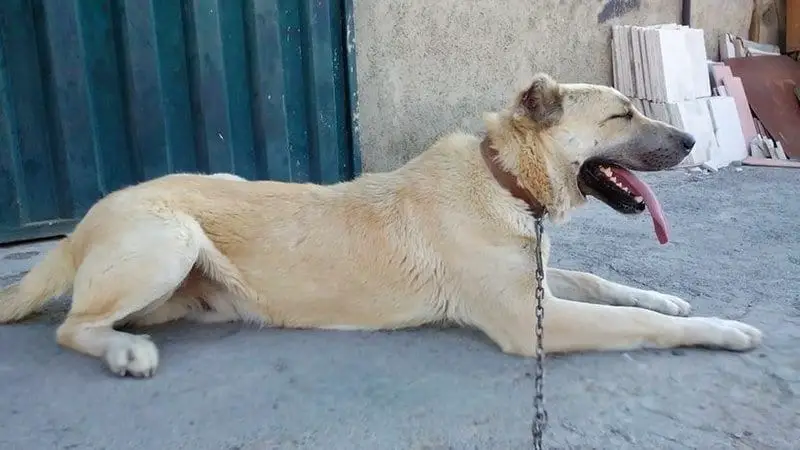
Description:
The Sarabi dog, also referred to as the Persian mastiff, Iranian Mastiff, or Iranian shepherd dog ( سگ سرابی ), is a large breed of dog that has heavy bones and a large head.
They stand between 28 and 35 inches tall and can weigh anywhere between 110-220 pounds, with females on the smaller side and large males on the heavier side.
The breed is one of the most powerful dogs worldwide and has a broad, mid-length muzzle. The breed has a long, thick, sickle-shaped tail and upper lips that hang down.
They come in short and medium-length coat types and shades of brown, with black masks on their face. In some cases, the entire body may be black.
Personality and Temperament:
The Sarabi Dog has long been used as a livestock and property guardian.
They are among the most powerful dogs worldwide, and their appearance reflects that.
This history, combined with their muscular and powerful appearance makes them excellent guard dogs.
When intruders are near, the Sarabi dog will quickly go into alert mode, and though it’s unlikely to partake in any direct conformation, it will stand its ground when needed.
While the breed is relatively aloof with strangers, they are friendly, loving, and loyal to their families.
They treat their family as a flock and guard them fiercely. This is a very large dog breed and doesn’t do well in apartment situations.
They need room to run and roam and need daily activity to help release their mental and physical energy.
History:
Sadly, not much has been documented about the history of the Sarabi dog breed.
What is known, however, is that they are indigenous to the city of Sarab in the North-Western area of Iran.
For many years, they were used by Iranian Shepherds to help guard their sheep against common predators like wolves, bears, and jackals.
The breed is thought to have evolved from Assyrian dogs and war dogs of Ancient Persia.
Did You Know?
- The Sarabi dog is unlikely to engage in confrontation, but if an intruder doesn’t back down, it will strike and defend
- The Sarabi dog is one of the most powerful dogs in the world and has an extremely powerful bite force.
- The Persian Sarabi dog has a long life span of 12-15 years
- The Sarabi Dog is the national dog of Iran.
3) Alabai (Sage Mazandarani)
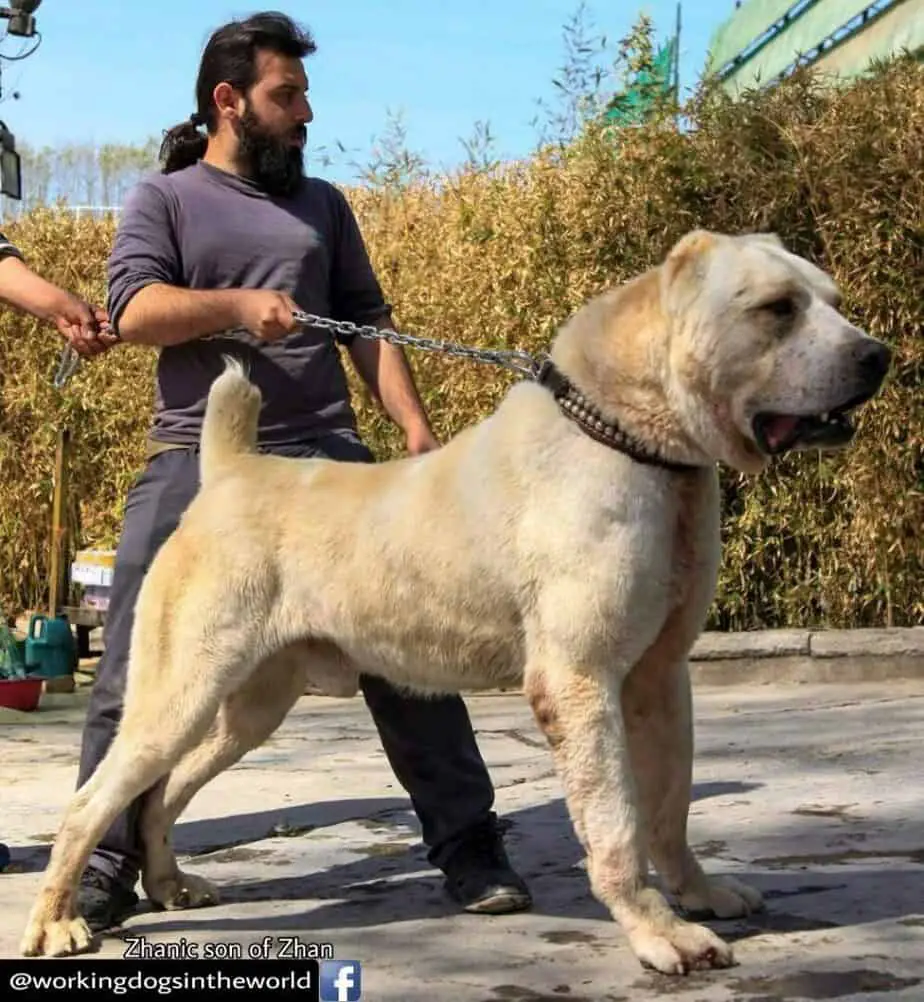
Description:
The Sage Mazandarani dog is a large breed separated into two different size categories. (image source)
Those traditionally used for hunting bears are considered the larger of the two, while those used for hunting large cats are typically learner and lighter. The average height for this breed is 28 inches.
Regardless of which category they fall into, both types of Alabai are strong and well-boned, bare powerful bodies, muzzles, and jaws, and strong and sturdy legs.
Though some dogs don’t, most Sage Mazandarani’s have cropped ears and tails.
The breed has mid-length fur in various colors but is typically white with dark patches.
On rare occasions, the dog may be solid black, where they are seen as the most valued.
Personality and Temperament:
The Sage Mazandarani is considered to be a very aggressive breed of dog and is still used today to hunt large prey like bears and leopards.
Their ability to hunt means they are both courageous and fearless but also highly territorial and protective.
Though the Sage Mazandarani is friendly, affectionate, and loving with its owners, it doesn’t do well with strangers or other dogs/animals.
History:
The Sage Mazandarani is an ancient breed of dog found throughout Northern Iran.
They are believed to be descendants of old Hyrcanian Mastiffs crossed with local livestock-guarding breeds.
The breed is primarily seen as a working dog and was originally imported to Russia as a bear hunter.
Did You Know?
- The Sage Mazandarani is very fast and athletic when working, but in their downtime, they like to laze and be inactive
4) Pshdar Dog ( Kurdish Mastiff )
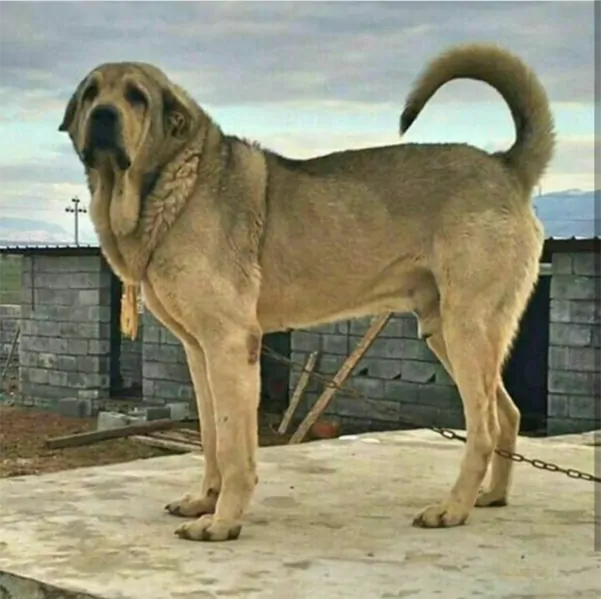
Description:
The Pshdar dog, now referred to as the Assyrian Shepherd dog, is a large breed of dog that stands between 75-90 cm tall, and weighs between 60-90 kilos, with females on the lighter end of the spectrum.
The breed has a deep and broad chest and strong and powerful jaws. They have small, floppy ears and a long tail that curls.
The breed is well known for the fold of loose skin that hangs from their neck, more commonly referred to as a dewlap.
The Pshdar dog has soft, loose skin with short to medium-length fur that comes in various colors, including black and white, grey, reddish-yellow, and so on.
Personality and Temperament:
The Pshdar is an intelligent breed of dog that is extremely devoted to its family and to its duty and role as protector.
The breed has long been used as a livestock guardian and takes its job of guarding very seriously. As such, the breed is hesitant of strangers and may bark a lot when unknown people are near.
This is not an aggressive breed of dog; they will stray away from trouble whenever possible.
The Pshdar is a very calm, laid back, easy going breed of dog that is both faithful and affectionate to its owners. The Pshdar does well with children but is not the “playful” type.
They are easily trained but do require a large yard to roam in. Pshdars do not make good apartment dogs.
History:
The Pshdar dog has been recorded in history for over 6000 years. This ancient breed has long been used as a guardian and protector.
They were originally bred by the Assyrians and Babylonians for protection against wild animals like lions and tigers but went on to become common cattle guardians.
The breed is becoming increasingly popular in Asia, Europe and America.
Did You Know?
- The Pshdar is one of the most powerful dog breeds in the world, and in history, it has been used to fend off large predators like lions, tigers, and wolves.
- Pshdar is one of the best “service” breeds in the world.
5) Alaunts

The Alaunt dog breed is an extinct breed of molosser dogs. Its original breed is said to have existed in Central Asia, the region of North Caucasus and Europe around the 17th century.
Description:
The original breed of this dog is said to have a resemblance with the Ovcharka, a Central Asian dog breed.
These breeds are described as large and short-coated mountain dogs having various types.
This drives me to the conclusion that many modern dog breeds are said to be direct descendants of this species.
Personality And Temperament:
- above average intelligence
- very easy to train them.
- very good watchdogs.
- very friendly with children.
- friendly with other dog species.
- Not apartment-friendly.
Grooming:
- minimal shedding
- low drooling tendency.
History of the Breed
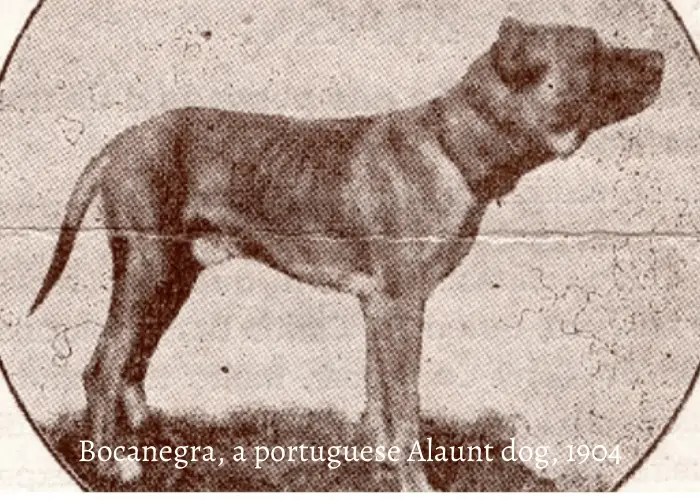
As recorded in history, the Alaunt breed is said to have been bred by the Alani tribe, the Sarmatian kavkaz nomads of Indian and Iranian ancestry. Outside of the Persian Empire, there existed an Iranian tribe generally overlooked majorly because of their independence from the central government.
They are also referred to as Alanis and settled in Pontic Steppe and the northern region of the black sea. They were considered expert breeders of dogs and horses and were responsible for introducing their dogs to Europe.
They were considered great warriors and herdsmen who bred dogs and horses. The purpose of breeding these dogs was because of their work, which was carried out to produce different classes within the breed to carry out specific duties.
So far, as recorded in history, the first ancestors of this breed were native breeds like the Alabai and Gampr of Central Asia and the Caucasus region and the hounds of Persia and India, which were shorthaired.
Many believed that the Albanian and Greek breeds were direct descendants of the white-colored Alaunt breed that had influenced many other white dog breeds in the Balkan region.
On the other hand, the Western Alani tribe got involved with the Vandals and followed them in their raids in the 410s through Europe.
They had fierce dogs, which influenced so many other breeds in Spain, England, Portugal, France, and some other countries, where the use of the name “Alaunt” was spread, making the breed synonymous with the title of a working dog rather than just a specific breed.
Furthermore, through breeding with other species like sighthounds and scenthounds, the breed became valued mainly as a game-hunting dog, with various species dictated according to preference.
The breed was separated in France according to their appearance and duties.
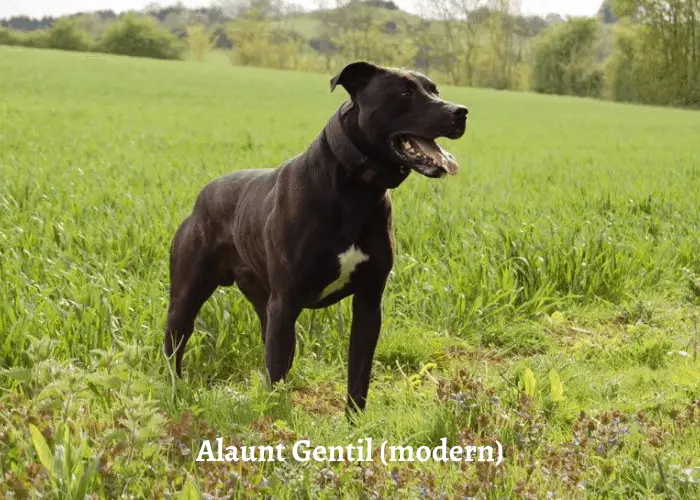
The types include the Alaunt Gentil, considered the lightest, looking like a greyhound, and eventually were bred with the Alaunt Veantre, a local hunting breed.
The heavier species, the Alaunt de Boucherie, played a vital role in developing France’s baiting and fighting dogs.
Other countries like Spain and England, repeated the same process, with bulldogs and mastiffs produced as the Alaunts were cross-bred, which influenced almost all European baiting, fighting and guarding dog breeds.
From what we know above, let us take a closer look at the types of the Alaunt breed.
The Alaunt Gentile:
The Alaunt Gentil, or the Alaunt Lebrel, was not a Greyhound, but it was instead made like its shape (that is the shape of the greyhound). Still, it had substantially a lesser bone structure, a short-muzzled head that was heavier than that of a greyhound, with a squarer jaw.
The Alaunt Veantre:
It has slouching ears, a bid head, and hanging lips. It was bred solely for hunting bear and wild boar.
The Alaunt Boucherie:
This breed of the Alaunt was known as the butcher’s mastiff in England.
It was in two forms, the larger and the smaller species, where the larger species are known as the Shepherd’s Mastiff and the smaller species known as the Butcher’s mastiff.
They both performed similar tasks to guard the herd and the house.
MODERN RELATIVES OF THE BREED
Fanatics of the Alaunt breed are now developing new breeds based on the Alaunt bloodline.
They include; the new Alaunt, the Abraxas bulldog, the American Alaunt, and the Dogo Belgrado.
Although its origin is still rooted in the ancient dog breeds of the east, the Alaunt breed is regarded as an original breed of the bulldog species.
European Dogs bred from the Alaunts Specie
The Spanish Bulldog:
Also known as the Alano Español, its name derived from the nomadic pastoralists of Alani tribe of Iran who arrived in Spain during the migration period of the 5th Century.
Bullen Beisser:
There is a belief that this breed has developed in Germany. They were believed to have developed due to cross-breeding with the Canis Alani species after Rome had fallen.
The English Mastiffs and Bulldogs:
In 50AD, Hadrian’s wall was guarded by about 5,500 Alanis, which saw the Alans providing a calvary for Rome.
Therefore, this gave rise to the crossing of the Alaunt breed giving rise to British repugnances as the fighting dogs, which are then believed to be the ancestors of the Bulldogs and the English mastiffs.
Presently, countless mastiff and bulldog breeds owe their existence to the Alaunt.
The Dogo Argentino:
It was believed that in the 1920s, the Dogo was developed by breeders who crossed the Cordoba Fighting Dog with other breeds like the Great Pyrenees, the Great Dane, Dogue de Bordeaux, Bull Terrier, and the English Bulldog.
Conclusion:

In summary, the dog breeds of Iran are just as loyal, loving, affectionate, and deserving as any other breed of dog from around the world.
Despite the belief by the Iranian government that these dogs spread “fear and anxiety” to the public, they are still beloved by many in the country.
If we can shed light on the many benefits of owning a dog – protection, love, loyalty, companionship, service, etc. – then we may eventually be able to change laws against dogs.
Dogs can’t speak for themselves, so it’s up to us to do it for them – so let’s start shedding some light!
Check Out More Asian Dog Breeds below:

